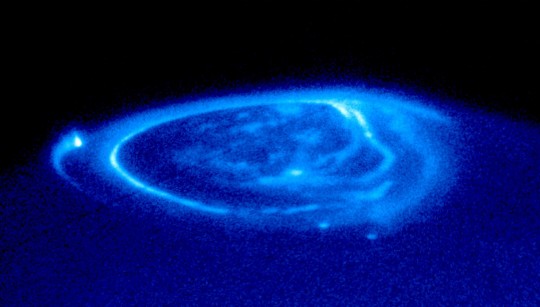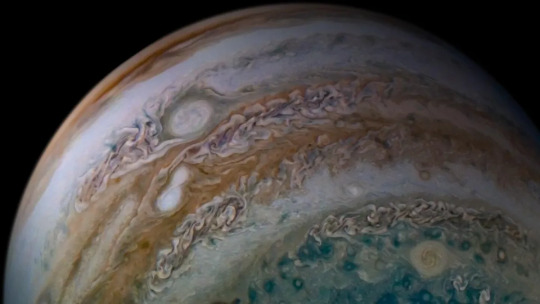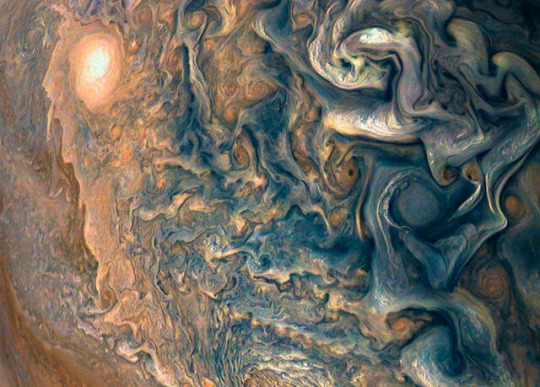#Jupiter's Atmosphere
Text
#SomewhereDeepInTheNight "A #cyclonicstorm in #Jupiter’s northern hemisphere is captured in this image from NASA’s #Juno spacecaft. Many bright white cloud tops can be seen popping up in and around the arms of the rotating storm."
1 note
·
View note
Text
The ability to fly would open up a new dimension to explore (in the mathematical-physical sense—we already know Danny had opened one up in the other sense). Think of how much Danny would notice that no one else would?
Think of bees. (Not so much birds, because we see birds all the time, and also because they don't seem quite as graceful and maneuverable as bees.) When I did a search for how high bees can fly, I found something that said bees could fly higher than Mount Everest (little edit: may've misunderstood what it meant. They might not've been found flying that high after all, just that 'they could'). Bees can go anywhere they want, just for fun.
We as humans tend to (for the most part) view the world as six feet high. Anything six feet or under, we know about (or possibly up to eight feet. But it's not much higher than our height). And we don't really realize we're thinking this way.
Sure, we can look upward, we can see treetops from a distance, we can see what the sky looks like. But it's from the perspective of looking up from a distance. Our worldview is colored by looking up from six feet or less.
It's a flat surface. Despite us knowing it's not flat, we don't really internalize it as being 3D and navigable. And we also don't realize what's up there. Who would ever imagine there were bees buzzing around the top of a 200 foot tree? To get to flowers we didn't even notice were up there?
And, yeah, we have planes, but they fly in a set path and you can only look down at the very distant ground. Helicopters are probably more similar, but not many people fly or ride those.
But Danny... after the accident, he would've started out sticking close to the ground a lot, but as he started getting more comfortable with the ability to fly, his worldview probably would've changed gradually. From his preconceived idea of 'the world is six feet or less' to 'the world is spacious and easily explored and so very 3D'.
There's an episode where he's vacuuming the living room ceiling—as though he thinks his parents will notice that it's cleaner than before. And though I understand the 'I have to clean everything so I don't get in trouble' impulse better than I should, there's a chance it's partly from Danny seeing the house differently than before. The ceiling becomes just another wall for him. ...One that he might clean often when he has cleaning chores, because he's going to notice all those spiderwebs and cobwebs, and the little bugs gathering in the light fixtures.
(...He probably would realize the ground is also navigable at some point, too. Think of all the tunnels and moles and snakes and other creatures he'll see, and all the plant roots and such.)
#danny phantom#danny fenton#just some thoughts#it's not really a 'what if' idea because it just... is.#asj post#I'd looked at some red buds on a maple tree using binoculars and kinda thought aloud 'I wonder what pollinates maple flowers'.#Because I knew maples had flowers because I'd seen something about it online once. ...I hadn't really realized it before then.#And my dad said probably Honey Bees. And I was like... 'bees fly that high?'#When my dad said he guessed so; I said I've always only seen them around this high (and put my hand at shin-level).#So... that's what made me realize there's a lot I just don't realize exists. From only living in a world near my height and below.#Planted to the ground.#...There was a post I saw awhile ago about people with weird ideas. One was about an illustration showing people standing on top of#the Earth and a person had been surprised because they thought we'd lived inside the Earth.#And actually... I thought the person could've been partially right. We don't live On Top of the Earth. We live under the atmosphere.#We're stuck halfway inside it. Under the layers of atmosphere but above the solid layers. Actually we're on the teeny tiny Crust layer.#I thought it was weird because when we talk about gas giants like Jupiter and Saturn we don't measure them based on their core size.#We measure them based on the size of their atmosphere.#So yeah we actually do live inside the Earth and not on top of it.#There was also a post I saw with a closeup of Saturn. Those clouds looked so 3D and thick and invitingly explorable. They looked bottomless#my search engine had answered the bee question wrong. but I did find something that said they'd definitely found Flies over 19000 ft.'#Not as high as Everest but still really high.
138 notes
·
View notes
Link
#atmospheric science#cyclone#fluid dynamics#Juno#Jupiter#physics#planetary science#science#vorticity
171 notes
·
View notes
Text


This is an electric-blue aurora that is eerily glowing one half billion miles away on the giant planet Jupiter. (Hi-Res 1, 2).
#jupiter#io#ganymede#europa#moon#moons#planet#planets#aurora#auroras#space#nasa#hubble space telescope#ultraviolet#solar wind#solar winds#magnetosphere#atmosphere#atmospheric phenomena#science
18 notes
·
View notes
Photo










#Mobile Suit Crossbone Gundam: Steel 7#Gundam F91 (Harrison Madin's Unit)#Gundam F90 Intercept Type Jupiter Battle Specification#Batalla#Char's Counterattack#Jagd Doga (Gyunei Guss Custom)#Gundam Reconguista in G#Gundam G-Self Atmospheric Pack#Mobile Suit Gundam: Iron-Blooded Orphans#Hyakuren#Gundam ZZ#Geymalk#Gundam Seed Destiny#Sword Impulse Gundam#Force Impulse Gundam#Saviour Gundam#Saviour Gundam (MA Mode)#Gundam Narrative#Jesta [Shezarr Type Team A]
94 notes
·
View notes
Text
HOW LONG WILL JUPITER’S STORM LAST??
Blog# 223
Wednesday, August 31st, 2022
Welcome back,
Jupiter is the biggest planet in our solar system, and its weather is quite unusual. Jupiter is encircled by storms. Some are small, while others are so massive that they can affect the entire planet. The most powerful of these storms is a very well-known Great Red Spot.
It's also made up of strong wind gusts that keep turning on and on. Such wind speeds are five times more effective than any massive storm on the planet. The Great Red Spot is Jupiter's storm's which is like "Oldest" storm and been spinning for a long time.

The iconic Great Red Spot of Jupiter may disappear in the next 20 years, according to a researcher at NASA's Jet Propulsion Laboratory (JPL) in California.
The massive storm — larger than Earth itself — was first spotted in 1830, and observations from the 1600s also revealed a giant spot on Jupiter's surface that may have been the same storm system. This suggests Jupiter's Great Red Spot (GRS) has been raging for centuries.

In a recent story, Business Insider spoke with Glenn Orton, a lead Juno mission team member and planetary scientist at NASA Jet Propulsion Laboratory (JPL), about the giant storm's fate.
According to Orton, the storm's vortex has maintained strength because of Jupiter's 300-400 mph (483-640 km/h) jetstreams, but like any storm, it won't go on forever. "In truth, the GRS has been shrinking for a long time," Orton told Business Insider.

"The GRS will in a decade or two become the GRC (Great Red Circle)," Orton said. "Maybe sometime after that the GRM," by which he means the "Great Red Memory."
In the late 1800s, the storm was perhaps as wide as 30 degrees longitude, Orton said. That works out to more than 35,000 miles — four times the diameter of Earth. When the nuclear-powered spacecraft Voyager 2 flew by Jupiter in 1979, however, the storm had shrunk to a bit more twice the width of our own planet.

Data on Jupiter's crimson-colored spot reveals that this shrinking is still occurring. As of April 3, 2017, the GRS spanned the width of 10,159 miles (16,350 kilometers), less than 1.3 times Earth's diameter. The longest storm on Earth lasted 31 days, but Jupiter can sustain longer storms because the gas planet has tens of thousands of miles of atmosphere, and spins much faster than Earth.
Originally published on www.space.com AND in.mashable.com
COMING UP!!
(Saturday, September 3rd, 2022)
“DOES THE MOON ROTATE??”
#astrophotography#astrophysics#Astronomy#spacecraft#outer space#Sunspot#atmosphere#space#Parallel Universe#white universe#alternate universe#universe#The Sun#spaceX#moon mars#moon#jupiter#solar radius#solar energy#solar system#solar panel
82 notes
·
View notes
Text
Y'all Ivy @ivystoryweaver put out a new fic about Poe Dameron and I don't think I'm ready but I am also SO ready. Gotta read it before I go see Spiderverse tonight, 'cause Priorities.

#ivystoryweaver#i heard you singing in a taco bell bathroom; i heard you singing a cheap trick song { arielle speaks }#now that she’s back in the atmosphere; with drops of jupiter in her hair { status update }
5 notes
·
View notes
Note
immensely enjoying seeing your astro tag on the dash everytime 🥰
I'm glad to hear that :D
I don't even follow any specifically astronomy blogs on here so it's really just me losing my mind whenever one of you reblogs a planet 😭
#btw the lore is that jupiter is my little babygirl i worked with her for 2 months last summer i know all about her atmosphere#and by extension all the gas giants are my girlies too#rocky planets are also cool actually all planets are cool#stars.... they are acceptable. i respect them#galaxies?....... i am looking away 😐 get that thing away from me 😔#if you want to know my beef with galaxies it's that are so BIG and SCARY and they make no sense#what tf is a 'dark matter' i'll kill u#joking i'm leaving that to the theoreticists. i'm only here to look at pretty planets
8 notes
·
View notes
Text
"NASA's James Webb Space Telescope has discovered a new, never-before-seen feature in Jupiter's atmosphere. The high-speed jet stream, which spans more than 3,000 miles (4,800 kilometers) wide, sits over Jupiter's equator above the main cloud decks. The discovery of this jet is giving insights into how the layers of Jupiter's famously turbulent atmosphere interact with each other, and how Webb is uniquely capable of tracking those features.
"This is something that totally surprised us," said Ricardo Hueso of the University of the Basque Country in Bilbao, Spain, lead author on the paper describing the findings. "What we have always seen as blurred hazes in Jupiter's atmosphere now appear as crisp features that we can track along with the planet's fast rotation."
The research team analyzed data from Webb's NIRCam (Near-Infrared Camera) captured in July 2022. The Early Release Science program—jointly led by Imke de Pater from the University of California, Berkeley and Thierry Fouchet from the Observatory of Paris—was designed to take images of Jupiter 10 hours apart, or one Jupiter day, in four different filters, each uniquely able to detect changes in small features at different altitudes of Jupiter's atmosphere.
"Even though various ground-based telescopes, spacecraft like NASA's Juno and Cassini, and NASA's Hubble Space Telescope have observed the Jovian system's changing weather patterns, Webb has already provided new findings on Jupiter's rings, satellites, and its atmosphere," de Pater noted."
continue article
#jupiter#astronomy#solar system#space#universe#cosmology#james webb space telescope#james webb telescope#jwst#spinning#rotation#atmosphere#layers of atmosphere#interaction#patterns#weather#cyclical#equator#jet stream
3 notes
·
View notes
Text
.
#oh wow the atmosphere in the household is rank#I think this is the first time I've tried to fight back with my parents and not cave and start crying yikes#i think this spell is going to last for a while#until school starts again at least#any possible last minute summer plans out the window I guess!!#already been going on with my dad for like two weeks but now it's going to be both parents#dad said he's not going to have any interest in what i do to prepare to apply to college now idk#only way i can not cry when someone is angry at me is be unbelievably rude back#going to match their energy I guess#haven't gone to the beach once this summer 😒#i said i didn't want to make a website solely for the sake of college apps from the very start and now look where we are#he said that i don't do anything i don't want to do and haven't given a single thought about my situation in life#goddamn!! do you think i like everything i do?? that I do things just because I enjoy them??#menopause hormones vs puberty hormones fight#feel like shit#next few weeks are going to be unbearable#upside is I don't have to worry about my dad walking in my room whenever and having to pretend to be busy#but my moms still going to do it and shes going to be passive agressive to jupiter and back!!#how can i be creative in these conditions
3 notes
·
View notes
Photo

Size of the planets from Astronomy for students and general readers. Simon Newcomb. 1880. https://newcatalog.library.cornell.edu/catalog/5431970
#astronomy#space#planets#solar system#space graphic#space illustration#planet illustration#saturn#neptune#jupiter#mercury#mars#venus#earth#uranus#sizes of the planets#simon newcomb#science#atmosphere#stars
11 notes
·
View notes
Text
"The color choices in this image reveal both the beauty of Jupiter and the subtle details present in Jupiter’s dynamic cloud structure. Each new observation that Juno provides of Jupiter’s atmosphere complements computer simulations and helps further refine our understanding of how the storms evolve over time."
#NASA#NASA JUNO#JUNO JUPITER MISSION#Jupiter's Atmosphere#Jupiter's North Pole#Somewhere Deep In The Night
0 notes
Note
Yknow what? 🍀 with mr thunder bird man! Or time man, either works!
"A human, asking advice from a Stardroid?" He gives a deep throated chuckle. Not a funny chuckle, but malicious with a bit of disbelief.

“Run or die.”

"My advice is don't ask his."
#thunderbird [jupiter]#stop the clock [timeman]#sorry wanted to kick Jup off with the more creepy atmosphere
5 notes
·
View notes
Link
48 notes
·
View notes
Text
{ A Quick Note: }
Yes. This is my reboot of my MULTIMUSE. Yes, it’s going to take months to get it back to where it was before I deleted it in a fit of psychosis. Yes, right now I’m here purely for @filedundercranberry && @all-cursed // @voices-ringing-out. Thank you for your time.

#out of this world { ooc }#allcursed#voicesringingout#filedundercranberry#now that she's back in the atmosphere; with drops of jupiter in her hair { status update }
3 notes
·
View notes
Link
In today's e[isode, we set sail through the cosmic seas beginning with the Hubble Space Telescope's 19-year odyssey, cataloging a flurry of elusive asteroids in a monumental cosmic census. Our journey takes a magnetic turn as we uncover how stellar magnetic fields are reshaping our understanding of exoplanet atmospheres, with a spotlight on the distant world of WASP 39 b. We then descend upon the mysterious ice of Ceres, where young, dynamic ice layers defy our expectations of these shadowy craters. Our quest for extraterrestrial life takes an unexpected twist with the potential of purple bacteria, offering a new palette in the search for life beyond Earth. For our grand finale, we soar over Jupiter's volcanic moon Io, with NASA's Juno mission revealing its fiery heart and enigmatic surface features like never before. Join us as we navigate these cosmic revelations, unraveling the secrets of the universe piece by piece.
---
**Featured Topics:**
1. **Hubble's Cosmic Census:** A 19-year journey through Hubble's archives uncovers over 1700 asteroid trails, enriching our understanding of the solar system.
2. **Stellar Magnetic Fields:** Exploring the magnetic influence on exoplanet atmospheres and its impact on our interpretations of distant worlds like WASP 39 b.
3. **Ceres' Ice Mysteries:** Delving into the surprising youthfulness of ice deposits on Ceres, challenging our perceptions of water in the asteroid belt.
4. **The Color Purple in Astrobiology:** Considering purple bacteria as a potential key to detecting alien life, expanding our search beyond Earth's greenery.
5. **Juno's Insights on Io:** An exhilarating close-up look at Io's volcanic activity and surface features, thanks to NASA's Juno mission flybys.
---
**Additional Information:**
Continue your cosmic journey with us at astronomydaily.io, where you can relive past episodes, stay updated with our space news feed, and subscribe to our free daily newsletter. Engage with fellow space enthusiasts and share your thoughts by leaving us a message. Keep the conversation going on X (formerly Twitter) by following us at @AstroDailypod. Your support and curiosity drive our voyage through the stars—until next time, this is Charlie, reminding you to keep looking up.
---
**Host Sign-off:** Charlie: As we conclude today's journey across the universe, I'm Charlie, thanking you for joining us on Astronomy Daily - The Podcast. Keep your eyes to the skies and your wonder alight, as there's always more to uncover in the vastness of space. Visit astronomydaily.io for more, and until our next cosmic encounter, clear skies and stellar dreams to all.
#39#alien#asteroid#atmospheres#b#bacteria#belt#census#ceres#detection#discoveries#exoplanet#fields#ice#jupiter's#life#magnetic#purple#stellar#wasp
0 notes